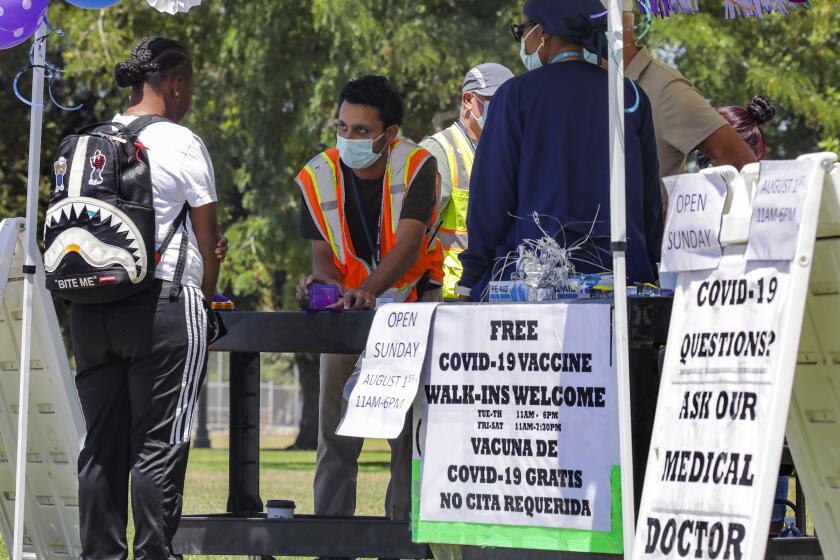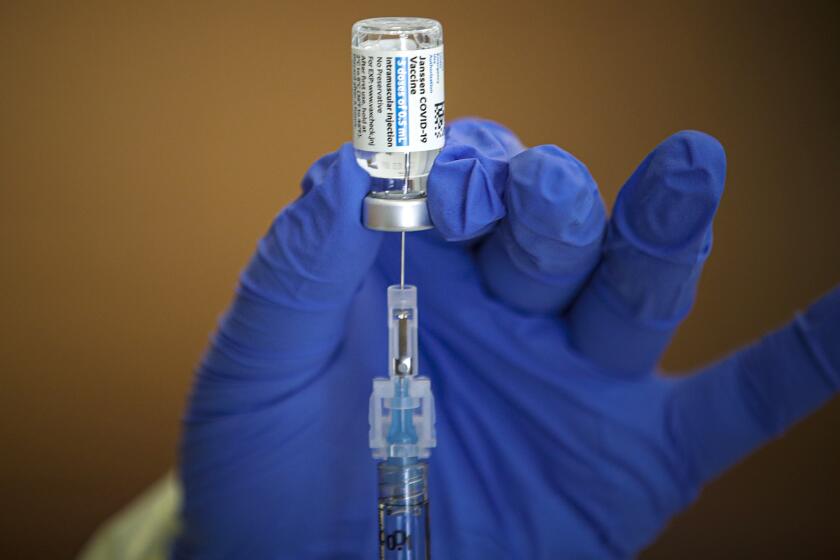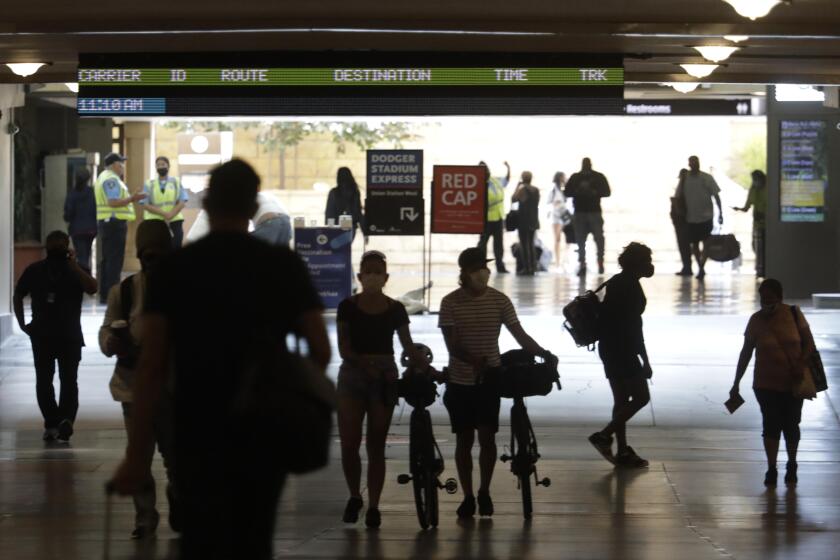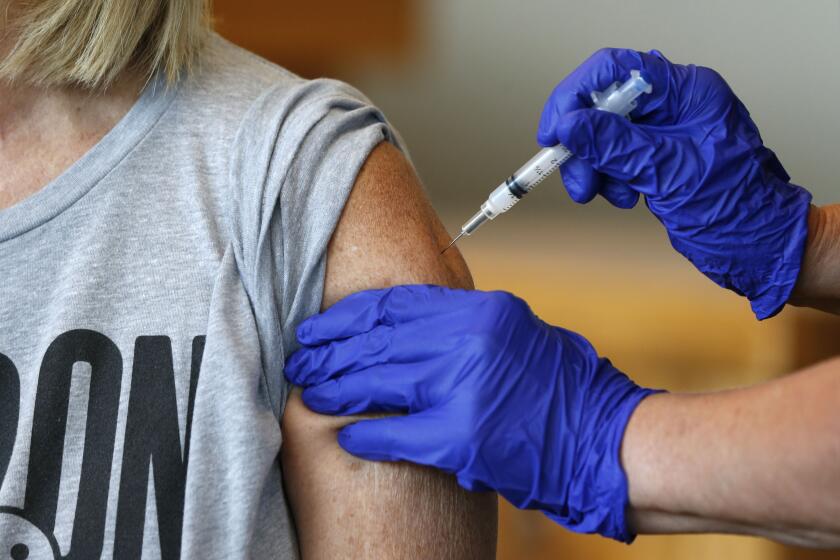COVID-19 hospitalizations rise sharply across Southern California as surge continues
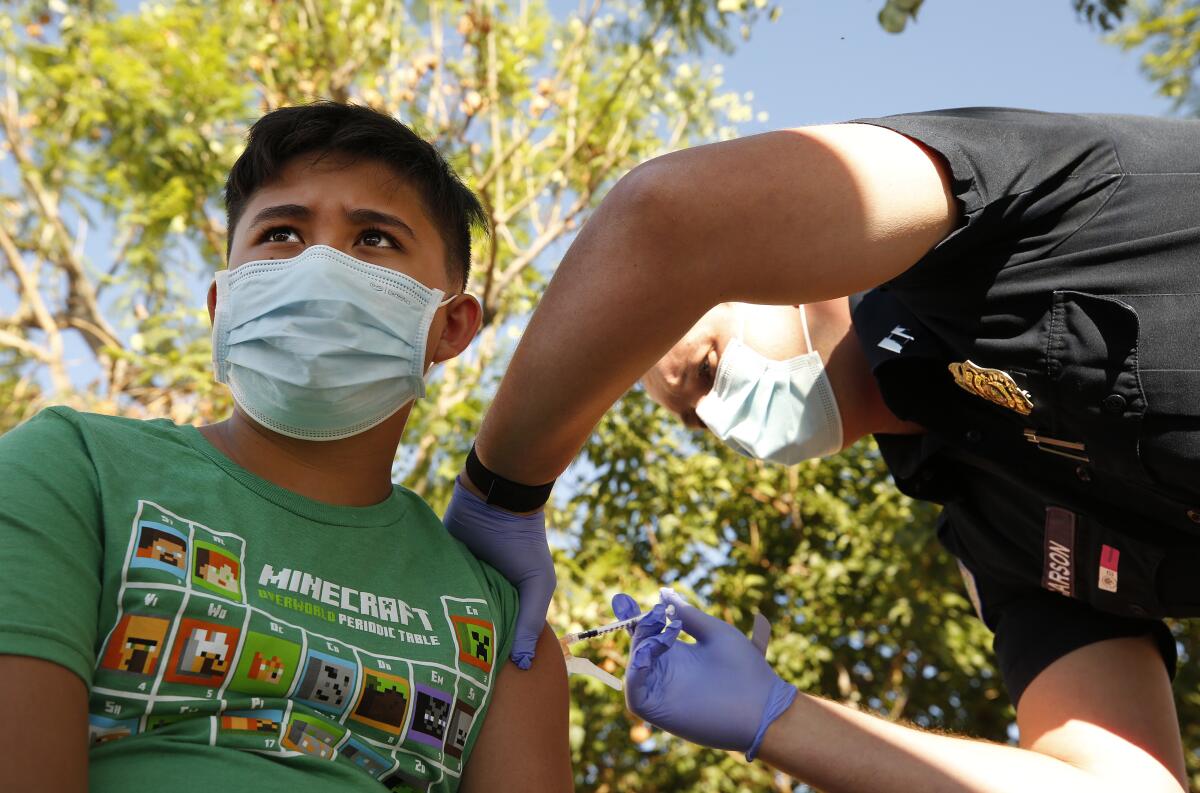
- Share via
COVID-19 hospitalizations have essentially doubled across much of California over the last two weeks — a troubling trend officials say illustrates the pandemic’s continued potency amid an ongoing surge in infections.
Increases of that magnitude have been seen in Los Angeles, San Diego, Orange, Riverside and San Bernardino counties, state data show, straining healthcare systems to an extent not seen in months.
Those counties — California’s five most populous — both reflect and drive the wider trends playing out across the state. California as a whole has seen its total number of hospitalized coronavirus-positive patients swell from 2,981 on July 25 to 5,973 as of Sunday.
“The significant increase in hospitalizations is of great concern,” L.A. County Public Health Director Barbara Ferrer said in a statement. “With the effectiveness of the COVID-19 vaccines, we are hopeful that more people will get vaccinated during this time of very high transmission.”
Officials had warned it was likely only a matter of time before California’s newest wave of coronavirus cases began to wash over hospitals. Throughout the pandemic, increases in infections have generally triggered corresponding rises in hospitalizations roughly two weeks later.
Over the last week, California has reported an average of just over 11,000 new coronavirus cases per day, according to data compiled by The Times. That’s about 90% higher than the average daily case count being recorded two weeks ago.
Over that same time period, the rate of increase in hospitalizations has also jumped sharply.
California’s rate of daily coronavirus infections underscores the extent to which the pandemic has roared back to life as the ultra-transmissible Delta variant storms across the state.
Between July 27 and Thursday, hospitalizations in Orange County jumped from 215 to 453 — more than doubling over the span of just nine days.
The number of COVID-19 patients rose to 463 on Saturday, the worst such number since late February, before falling slightly to 453 on Sunday.
In L.A. County, hospitalizations have doubled in the last 15 days, from 745 on July 24 to 1,503 on Sunday, also the region’s worst number since the waning days of the devastating fall and winter surge.
Hospitalizations shot up from 239 on July 26 to 484 on Sunday in San Diego County, and have also at least doubled over the last 15 days in Riverside, San Bernardino and Ventura counties.
Southern California isn’t an outlier. Across the nine-county San Francisco Bay Area, there were a combined 436 COVID-19 patients hospitalized on July 22. By Sunday, there were 881.
Similarly, in Sacramento County, hospitalizations doubled from 148 on July 24 to 315 on Sunday. In Fresno County, they doubled from 100 on July 28 to 214 on Sunday.
Although the counts have yet to reach the harrowing levels seen over the fall and winter, the flood of new COVID-19 patients presents just the latest challenge for the state’s beleaguered hospitals and healthcare workers.
In a letter last week, Dr. Carl Schultz, emergency medical services director for the Orange County Health Care Agency, urged the region’s hospitals to take steps to reduce ambulance patient offload times — as well as the number of hours they’re spending on diversion, when ambulances are redirected to other medical facilities.
“This is not sustainable,” he wrote in the letter Wednesday. “We have not witnessed increases in ambulance-related numbers of this magnitude since the worst days of the second surge in December of 2020 and January of 2021.”
Since the letter went out, there’s already been some progress in terms of reducing diversion hours and patient offload times, Schultz said during a news briefing Monday.
“We’re still in an area where I’m worried, but we’re not in a crisis right now,” he said.
Instead of a back-to-normal back-to-school, the coronavirus casts new shadows over the return to full-time, in-person schooling.
Throughout California, according to a Times analysis, 14 counties are reporting per capita rates of more than 20 COVID-19 hospitalized patients for every 100,000 residents — as bad as the rate of hospitalized flu patients during the peak of the flu season.
The hardest-hit counties are in and around the Central Valley, including Sacramento, Fresno, San Joaquin, Stanislaus, Solano, Placer, Butte, Kings, Nevada, Yuba, Tuolumne and Amador counties, as well as Lake and Del Norte counties in Northern California.
Some experts have said that when COVID-19 hospitalizations exceed 5 hospitalizations for every 100,000 residents, that’s a time to consider returning to universal masking.
Health officials say they’re largely unnecessary and the primary focus should be getting the unvaccinated to roll up their sleeves.
The most populated Southern California counties have more than doubled or tripled that threshold, with Ventura County reporting 12 hospitalizations for every 100,000 residents; Orange County, 14; Los Angeles and San Diego counties, 15; Riverside County, 18; and San Bernardino County, 19.
L.A. County was the first county in Southern California this summer to have a mandatory mask order for indoor public areas, regardless of vaccination status; Santa Barbara County issued a similar order last week. San Diego, Orange, Riverside, San Bernardino and Ventura counties have not followed suit.
By comparison, the nine-county San Francisco Bay Area is reporting 11 COVID-19 hospitalizations per 100,000 residents; while Sacramento County is reporting 21 and Fresno County, 22. Sacramento County and all but one county in the Bay Area have ordered masks to be worn in indoor public spaces.
Many health officials have characterized the rising hospital census as equal parts cautionary tale and clarion call — demonstrative both of the dangers still posed by COVID-19 and the importance of getting vaccinated.
This week, leaders of the city of Los Angeles city as well as county supervisors will consider vaccination mandates for a wide swath of public places.
Data continue to show that the vast majority of those getting infected by, and ultimately hospitalized with, COVID-19 are uninoculated.
For the week of July 31, the average coronavirus case rate among unvaccinated Californians was 33 per 100,000 residents per day, nearly five times the comparable rate of vaccinated individuals.
As of last week, Ferrer pegged the risk of being hospitalized for COVID-19 in L.A. County as 19 times higher among those who are not fully vaccinated than it is for those who are.
And in Orange County, Supervisor Katrina Foley said Monday that 90% of COVID-19 patients that have been hospitalized have been unvaccinated.
“As one doctor shared with me: Choosing not to get vaccinated is choosing to get COVID,” she told reporters during a briefing.
With breakthrough infections, Delta variant rising, what should I do to protect myself?
Officials and experts have said the latest surge is being fueled by the Delta variant, which is believed to be the most transmissible version of the coronavirus yet.
Scientists have established that people infected with Delta have about 1,000 times more viral particles in their upper respiratory systems than people who are infected with earlier coronavirus strains.
Experts say the ultra-contagious nature of Delta means it can jump from person to person just four days after an initial infection, instead of the six days it did with previous strains.
All this means Delta can spread rapidly among the uninoculated, even in areas with high levels of vaccine coverage overall.
“Very few of us are going to get out [of the pandemic] without either getting COVID illness or getting vaccinated,” said Dr. Matthew Zahn, Orange County’s deputy health officer and a pediatric infectious disease expert. “And, clearly, getting vaccinated is the safer, healthier way for us to go.”
Times staff writers Karen Kaplan and Melissa Healy contributed to this report.
More to Read
Sign up for Essential California
The most important California stories and recommendations in your inbox every morning.
You may occasionally receive promotional content from the Los Angeles Times.
